Deck 2: Cat Dissection Exercises
Question
Question
Question
Question
Question
Question
Question
Question
Question
Question
Question
Question
Question
Question
Question
Question
Question
Question
Question
Question
Question
Question
Question
Question
Question
Question
Question
Question
Question
Question
Question
Question
Question
Question
Question
Question
Question
Question
Question
Question
Question
Question
Question
Question
Question
Question
Question
Question
Question
Question
Question
Question
Question
Question
Question
Question
Question
Question
Question
Question
Question
Question
Question
Question
Question
Question
Question
Question
Question
Question
Question
Question
Question
Question
Question
Question
Question
Question
Question
Question

Unlock Deck
Sign up to unlock the cards in this deck!
Unlock Deck
Unlock Deck
1/178
Play
Full screen (f)
Deck 2: Cat Dissection Exercises
1
Which of the following muscles is NOT located in the neck?
A) sternomastoid
B) teres major
C) sternohyoid
D) digastric
E) mylohyoid
A) sternomastoid
B) teres major
C) sternohyoid
D) digastric
E) mylohyoid
B
2
Which muscle, that originates on the acromion process of the scapula and inserts on the proximal end of the humerus, functions to flex the forelimb and rotate it laterally?
A) levator scapulae ventralis
B) clavodeltoid
C) acromiotrapezius
D) latissimus dorsi
E) acromiodeltoid
A) levator scapulae ventralis
B) clavodeltoid
C) acromiotrapezius
D) latissimus dorsi
E) acromiodeltoid
E
3
Which group of muscles covers the ventral surface of the chest?
A) trapezius group
B) deltoid group
C) rhomboideus group
D) pectoralis group
A) trapezius group
B) deltoid group
C) rhomboideus group
D) pectoralis group
D
4
Which muscle of the rhomboideus group is NOT found in humans?
A) rhomboideus major
B) rhomboideus capitus
C) rhomboideus minor
A) rhomboideus major
B) rhomboideus capitus
C) rhomboideus minor

Unlock Deck
Unlock for access to all 178 flashcards in this deck.
Unlock Deck
k this deck
5
Which muscle of the neck functions to turn and depress the head?
A) sternomastoid
B) mylohyoid
C) digastric
D) sternohyoid
A) sternomastoid
B) mylohyoid
C) digastric
D) sternohyoid

Unlock Deck
Unlock for access to all 178 flashcards in this deck.
Unlock Deck
k this deck
6
Which muscle is located at the axillary border of the scapula?
A) splenius
B) supraspinatus
C) infraspinatus
D) rhomboideus major
E) teres major
A) splenius
B) supraspinatus
C) infraspinatus
D) rhomboideus major
E) teres major

Unlock Deck
Unlock for access to all 178 flashcards in this deck.
Unlock Deck
k this deck
7
Cats have all of the same muscles as humans, and therefore they are an ideal specimen to study.
A) True
B) False
A) True
B) False

Unlock Deck
Unlock for access to all 178 flashcards in this deck.
Unlock Deck
k this deck
8
Which group of muscles covers the dorsal surface of the neck and scapula?
A) trapezius group
B) deltoid group
C) rhomboideus group
D) pectoralis group
A) trapezius group
B) deltoid group
C) rhomboideus group
D) pectoralis group

Unlock Deck
Unlock for access to all 178 flashcards in this deck.
Unlock Deck
k this deck
9
Which muscle is a broad, flat, and thin muscle that covers most of the lateral surface of the cervical and thoracic vertebrae?
A) teres major
B) supraspinatus
C) infraspinatus
D) rhomboideus major
E) splenius
A) teres major
B) supraspinatus
C) infraspinatus
D) rhomboideus major
E) splenius

Unlock Deck
Unlock for access to all 178 flashcards in this deck.
Unlock Deck
k this deck
10
In cats, the trapezius group of muscles is composed of three distinct muscles. How many muscle(s) make up the trapezius in humans?
A) two
B) one
C) three
D) four
A) two
B) one
C) three
D) four

Unlock Deck
Unlock for access to all 178 flashcards in this deck.
Unlock Deck
k this deck
11
Which term refers to the tail end of a four-legged animal?
A) superior
B) caudal
C) inferior
D) cephalic
A) superior
B) caudal
C) inferior
D) cephalic

Unlock Deck
Unlock for access to all 178 flashcards in this deck.
Unlock Deck
k this deck
12
How should the skin be separated from the underlying fascia?
A) use the pointed end of a pair of scissors to separate the skin from the underlying muscle and connective tissues
B) use the scalpel to separate the skin from the underlying muscle and connective tissues
C) use your fingers or a blunt probe to separate the skin from the underlying muscle and connective tissues
A) use the pointed end of a pair of scissors to separate the skin from the underlying muscle and connective tissues
B) use the scalpel to separate the skin from the underlying muscle and connective tissues
C) use your fingers or a blunt probe to separate the skin from the underlying muscle and connective tissues

Unlock Deck
Unlock for access to all 178 flashcards in this deck.
Unlock Deck
k this deck
13
Where should the first incision be made when dissecting a cat?
A) on the lateral side of the ventral surface near the neck
B) on the midline of the ventral surface just anterior to the tail
C) on the lateral side of the dorsal surface near the neck
D) on the midline of the dorsal surface just anterior to the tail
A) on the lateral side of the ventral surface near the neck
B) on the midline of the ventral surface just anterior to the tail
C) on the lateral side of the dorsal surface near the neck
D) on the midline of the dorsal surface just anterior to the tail

Unlock Deck
Unlock for access to all 178 flashcards in this deck.
Unlock Deck
k this deck
14
Which letter is marking the teres major in this figure? 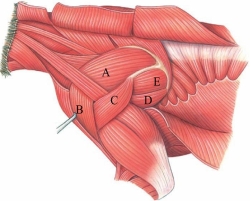
A) A
B) B
C) C
D) D
E) E

A) A
B) B
C) C
D) D
E) E

Unlock Deck
Unlock for access to all 178 flashcards in this deck.
Unlock Deck
k this deck
15
Which term refers to the ventral surface of a four-legged animal?
A) inferior
B) superior
C) caudal
D) cephalic
A) inferior
B) superior
C) caudal
D) cephalic

Unlock Deck
Unlock for access to all 178 flashcards in this deck.
Unlock Deck
k this deck
16
Which group of muscles comprises the shoulder muscles?
A) trapezius group
B) deltoid group
C) rhomboideus group
D) pectoralis group
A) trapezius group
B) deltoid group
C) rhomboideus group
D) pectoralis group

Unlock Deck
Unlock for access to all 178 flashcards in this deck.
Unlock Deck
k this deck
17
Which muscle is a large, flat muscle that lays posterior to the trapezius group?
A) deltoid group
B) levator scapulae ventralis
C) latissimus dorsi
D) supraspinatus
A) deltoid group
B) levator scapulae ventralis
C) latissimus dorsi
D) supraspinatus

Unlock Deck
Unlock for access to all 178 flashcards in this deck.
Unlock Deck
k this deck
18
Which statement regarding the storage of your cat is most correct?
A) The cat should be stored in a sealed bag covered in distilled water.
B) The cat should be stored in a sealed bag with exposed muscles covered with paper towels that have been dampened with fixative.
C) The cat should be dried and stored in a sealed bag.
D) The cat should be stored on the dissecting pan without any coverings.
A) The cat should be stored in a sealed bag covered in distilled water.
B) The cat should be stored in a sealed bag with exposed muscles covered with paper towels that have been dampened with fixative.
C) The cat should be dried and stored in a sealed bag.
D) The cat should be stored on the dissecting pan without any coverings.

Unlock Deck
Unlock for access to all 178 flashcards in this deck.
Unlock Deck
k this deck
19
To begin dissecting the cat, place it ________ side down on the dissecting tray.
A) dorsal
B) caudal
C) cephalic
D) ventral
A) dorsal
B) caudal
C) cephalic
D) ventral

Unlock Deck
Unlock for access to all 178 flashcards in this deck.
Unlock Deck
k this deck
20
Which of the following muscles is NOT found in humans?
A) levator scapulae ventralis
B) latissimus dorsi
C) trapezius
D) deltoid
A) levator scapulae ventralis
B) latissimus dorsi
C) trapezius
D) deltoid

Unlock Deck
Unlock for access to all 178 flashcards in this deck.
Unlock Deck
k this deck
21
Which of the following abdominal muscles do the other three abdominal muscles insert on?
A) rectus abdominis
B) internal oblique
C) external oblique
D) transverse abdominis
A) rectus abdominis
B) internal oblique
C) external oblique
D) transverse abdominis

Unlock Deck
Unlock for access to all 178 flashcards in this deck.
Unlock Deck
k this deck
22
The muscles of the pectoralis group originate on which bone?
A) humerus
B) sternum
C) clavicle
D) cervical vertebra
E) mandible
A) humerus
B) sternum
C) clavicle
D) cervical vertebra
E) mandible

Unlock Deck
Unlock for access to all 178 flashcards in this deck.
Unlock Deck
k this deck
23
Which muscle is correctly matched to its origin and insertion?
A) sartorius; originates on the ischium and pubic symphysis and inserts on the medial surface of the tibia
B) gluteus medius; originates on the ilium and the transverse processes of the last sacral and first caudal vertebrae and inserts on the femur
C) gracilis; originates on the ischial tuberosity and inserts on the tibia
D) pectineus; originates on the crest of the ilium and inserts into the fascia lata
A) sartorius; originates on the ischium and pubic symphysis and inserts on the medial surface of the tibia
B) gluteus medius; originates on the ilium and the transverse processes of the last sacral and first caudal vertebrae and inserts on the femur
C) gracilis; originates on the ischial tuberosity and inserts on the tibia
D) pectineus; originates on the crest of the ilium and inserts into the fascia lata

Unlock Deck
Unlock for access to all 178 flashcards in this deck.
Unlock Deck
k this deck
24
How many points of origin does the triceps brachii have?
A) one
B) two
C) three
D) four
A) one
B) two
C) three
D) four

Unlock Deck
Unlock for access to all 178 flashcards in this deck.
Unlock Deck
k this deck
25
Identify the serratus dorsalis in the following image. 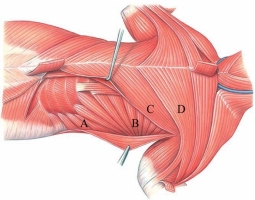
A) A
B) B
C) C
D) D

A) A
B) B
C) C
D) D

Unlock Deck
Unlock for access to all 178 flashcards in this deck.
Unlock Deck
k this deck
26
Which of the following muscles functions to extend the foot?
A) extensor digitorum longus
B) flexor digitorum longus
C) fibularis longus
D) fibularis tertius
E) gastrocnemius
A) extensor digitorum longus
B) flexor digitorum longus
C) fibularis longus
D) fibularis tertius
E) gastrocnemius

Unlock Deck
Unlock for access to all 178 flashcards in this deck.
Unlock Deck
k this deck
27
Which muscle of the hamstring group functions to extend the thigh?
A) biceps femoris
B) semitendinosus
C) semimembranosus
D) vastus lateralis
A) biceps femoris
B) semitendinosus
C) semimembranosus
D) vastus lateralis

Unlock Deck
Unlock for access to all 178 flashcards in this deck.
Unlock Deck
k this deck
28
Which of the following muscles is correctly matched to its origin and insertion?
A) fibularis longus; originates on the tibial tuberosity and inserts on each of the five digits
B) extensor digitorum longus; originates on the lateral epicondyle of the femur and inserts on each of the five digits
C) gastrocnemius; originates on the proximal ends of the tibia and fibula and inserts on the first metatarsal
D) tibialis anterior; originates on the fibula and inserts on the calcaneus
E) fibularis brevis; originates on the fibula and inserts on the base of the fifth metatarsal
A) fibularis longus; originates on the tibial tuberosity and inserts on each of the five digits
B) extensor digitorum longus; originates on the lateral epicondyle of the femur and inserts on each of the five digits
C) gastrocnemius; originates on the proximal ends of the tibia and fibula and inserts on the first metatarsal
D) tibialis anterior; originates on the fibula and inserts on the calcaneus
E) fibularis brevis; originates on the fibula and inserts on the base of the fifth metatarsal

Unlock Deck
Unlock for access to all 178 flashcards in this deck.
Unlock Deck
k this deck
29
Identify the muscle labeled "A" in the following figure. 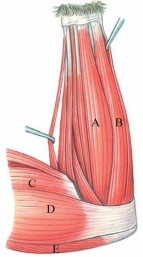
A) palmaris longus
B) flexor carpi ulnaris
C) biceps brachii
D) epitrochlearis
E) triceps brachii

A) palmaris longus
B) flexor carpi ulnaris
C) biceps brachii
D) epitrochlearis
E) triceps brachii

Unlock Deck
Unlock for access to all 178 flashcards in this deck.
Unlock Deck
k this deck
30
Which muscle is located on the ventrolateral surface of the humerus and functions to flex the forelimb?
A) biceps brachii
B) brachialis
C) triceps brachii
D) brachioradialis
A) biceps brachii
B) brachialis
C) triceps brachii
D) brachioradialis

Unlock Deck
Unlock for access to all 178 flashcards in this deck.
Unlock Deck
k this deck
31
The biceps brachii functions as ________.
A) an extensor of the carpal joints
B) an extensor of the forelimb
C) a flexor of the digits
D) a flexor of the forelimb
A) an extensor of the carpal joints
B) an extensor of the forelimb
C) a flexor of the digits
D) a flexor of the forelimb

Unlock Deck
Unlock for access to all 178 flashcards in this deck.
Unlock Deck
k this deck
32
Which of the following muscles is NOT a component of the quadriceps femoris?
A) biceps femoris
B) vastus lateralis
C) vastus intermedius
D) vastus medialis
E) tectus femoris
A) biceps femoris
B) vastus lateralis
C) vastus intermedius
D) vastus medialis
E) tectus femoris

Unlock Deck
Unlock for access to all 178 flashcards in this deck.
Unlock Deck
k this deck
33
Which muscle functions to adduct and rotate the femur as well as extend the tibia?
A) gluteus medius
B) gracilis
C) sartorius
D) pectineus
A) gluteus medius
B) gracilis
C) sartorius
D) pectineus

Unlock Deck
Unlock for access to all 178 flashcards in this deck.
Unlock Deck
k this deck
34
Which of these muscles is the most superficial and lateral muscle of the abdominal muscles?
A) external oblique
B) internal oblique
C) transverse abdominis
D) rectus abdominis
A) external oblique
B) internal oblique
C) transverse abdominis
D) rectus abdominis

Unlock Deck
Unlock for access to all 178 flashcards in this deck.
Unlock Deck
k this deck
35
How many layers of muscles comprise the intercostal group of muscles?
A) one
B) two
C) three
D) four
A) one
B) two
C) three
D) four

Unlock Deck
Unlock for access to all 178 flashcards in this deck.
Unlock Deck
k this deck
36
Which muscle of the neck functions to elevate the mandible?
A) mylohyoid
B) masseter
C) digastric
D) sternohyoid
E) sternomastoid
A) mylohyoid
B) masseter
C) digastric
D) sternohyoid
E) sternomastoid

Unlock Deck
Unlock for access to all 178 flashcards in this deck.
Unlock Deck
k this deck
37
Identify the fibularis longus in the following figure. 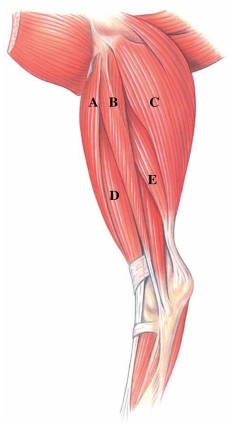
A) A
B) B
C) C
D) D
E) E

A) A
B) B
C) C
D) D
E) E

Unlock Deck
Unlock for access to all 178 flashcards in this deck.
Unlock Deck
k this deck
38
Identify the serratus ventralis in the following image. 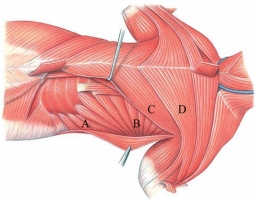
A) A
B) B
C) C
D) D

A) A
B) B
C) C
D) D

Unlock Deck
Unlock for access to all 178 flashcards in this deck.
Unlock Deck
k this deck
39
Which muscle is found in cats but NOT humans?
A) biceps brachii
B) epitrochlearis
C) flexor carpi radialis
D) brachialis
A) biceps brachii
B) epitrochlearis
C) flexor carpi radialis
D) brachialis

Unlock Deck
Unlock for access to all 178 flashcards in this deck.
Unlock Deck
k this deck
40
Which muscle of the quadriceps femoris group lies deep to the rectus femoris?
A) vastus lateralis
B) vastus intermedius
C) vastus medialis
D) semimembranosus
A) vastus lateralis
B) vastus intermedius
C) vastus medialis
D) semimembranosus

Unlock Deck
Unlock for access to all 178 flashcards in this deck.
Unlock Deck
k this deck
41
Identify the common fibular nerve in the following figure. 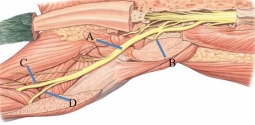
A) A
B) B
C) C
D) D

A) A
B) B
C) C
D) D

Unlock Deck
Unlock for access to all 178 flashcards in this deck.
Unlock Deck
k this deck
42
List the layers of the meningeal membranes surrounding the brain and spinal cord from most superficial to deepest: 1. Pia mater
2) Arachnoid mater
3) Dura mater
A) 3, 2, 1
B) 1, 2, 3
C) 1, 3, 2
D) 3, 1, 2
E) 2, 3, 1
2) Arachnoid mater
3) Dura mater
A) 3, 2, 1
B) 1, 2, 3
C) 1, 3, 2
D) 3, 1, 2
E) 2, 3, 1

Unlock Deck
Unlock for access to all 178 flashcards in this deck.
Unlock Deck
k this deck
43
Damage to the radial nerve would impact which muscle?
A) coracobrachialis
B) biceps brachii
C) triceps brachii
D) pectoralis
A) coracobrachialis
B) biceps brachii
C) triceps brachii
D) pectoralis

Unlock Deck
Unlock for access to all 178 flashcards in this deck.
Unlock Deck
k this deck
44
Which nerve extends along the lateral side of the hindlimb?
A) median nerve
B) tibial nerve
C) common fibular nerve
D) musculocutaneous nerve
A) median nerve
B) tibial nerve
C) common fibular nerve
D) musculocutaneous nerve

Unlock Deck
Unlock for access to all 178 flashcards in this deck.
Unlock Deck
k this deck
45
Identify the sciatic nerve in the following figure. 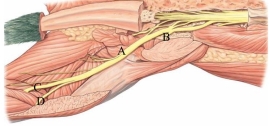
A) A
B) B
C) C
D) D

A) A
B) B
C) C
D) D

Unlock Deck
Unlock for access to all 178 flashcards in this deck.
Unlock Deck
k this deck
46
Identify the radial nerve in the following image. 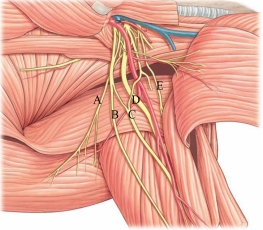
A) A
B) B
C) C
D) D
E) E

A) A
B) B
C) C
D) D
E) E

Unlock Deck
Unlock for access to all 178 flashcards in this deck.
Unlock Deck
k this deck
47
Which nerve is the most posterior nerve of the brachial plexus?
A) ulnar nerve
B) radial nerve
C) brachial nerve
D) median nerve
A) ulnar nerve
B) radial nerve
C) brachial nerve
D) median nerve

Unlock Deck
Unlock for access to all 178 flashcards in this deck.
Unlock Deck
k this deck
48
The spinal nerves are formed by the ________.
A) dorsal and ventral roots
B) pia mater
C) dura mater
A) dorsal and ventral roots
B) pia mater
C) dura mater

Unlock Deck
Unlock for access to all 178 flashcards in this deck.
Unlock Deck
k this deck
49
Which nerve plexus is shown in this figure? 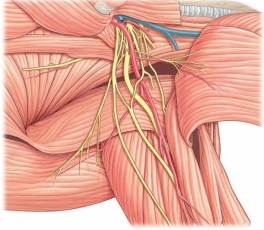
A) lumbar plexus
B) sacral plexus
C) brachial plexus
D) cervical plexus

A) lumbar plexus
B) sacral plexus
C) brachial plexus
D) cervical plexus

Unlock Deck
Unlock for access to all 178 flashcards in this deck.
Unlock Deck
k this deck
50
Which two muscles act antagonistically?
A) tibialis anterior; fibularis longus
B) flexor digitorum longus; gastrocnemius
C) gastrocnemius; soleus
D) extensor digitorum longus; flexor digitorum longus
A) tibialis anterior; fibularis longus
B) flexor digitorum longus; gastrocnemius
C) gastrocnemius; soleus
D) extensor digitorum longus; flexor digitorum longus

Unlock Deck
Unlock for access to all 178 flashcards in this deck.
Unlock Deck
k this deck
51
Which muscle lies deep to the gastrocnemius?
A) extensor digitorum longus
B) fibularis longus
C) soleus
D) tibialis anterior
A) extensor digitorum longus
B) fibularis longus
C) soleus
D) tibialis anterior

Unlock Deck
Unlock for access to all 178 flashcards in this deck.
Unlock Deck
k this deck
52
To dissect the spinal cord, you must first cut through this, the outermost layer of the meninges.
A) dura mater
B) arachnoid mater
C) pia mater
A) dura mater
B) arachnoid mater
C) pia mater

Unlock Deck
Unlock for access to all 178 flashcards in this deck.
Unlock Deck
k this deck
53
Identify the thymus gland in the following figure. 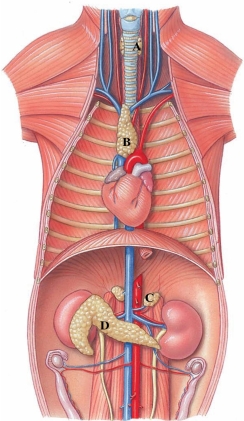
A) A
B) B
C) C
D) D

A) A
B) B
C) C
D) D

Unlock Deck
Unlock for access to all 178 flashcards in this deck.
Unlock Deck
k this deck
54
Identify the median nerve in the following image. 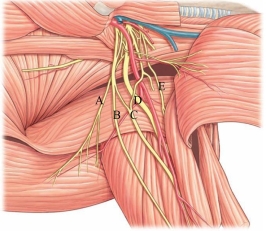
A) A
B) B
C) C
D) D
E) E

A) A
B) B
C) C
D) D
E) E

Unlock Deck
Unlock for access to all 178 flashcards in this deck.
Unlock Deck
k this deck
55
Which nerve supplies the coracobrachial and biceps brachii muscles of the ventral forelimb and the skin of the forelimb?
A) musculocutaneous nerve
B) radial nerve
C) median nerve
D) ulnar nerve
A) musculocutaneous nerve
B) radial nerve
C) median nerve
D) ulnar nerve

Unlock Deck
Unlock for access to all 178 flashcards in this deck.
Unlock Deck
k this deck
56
Identify the adrenal gland in the following figure. 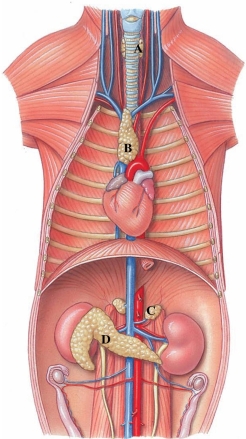
A) A
B) B
C) C
D) D

A) A
B) B
C) C
D) D

Unlock Deck
Unlock for access to all 178 flashcards in this deck.
Unlock Deck
k this deck
57
In the spinal cord the ________ matter is deep to the ________ matter.
A) gray; white
B) white; gray
A) gray; white
B) white; gray

Unlock Deck
Unlock for access to all 178 flashcards in this deck.
Unlock Deck
k this deck
58
Both cats and humans have pairs of spinal nerves extending from the spinal cord. While cats have between 38 to 40 pairs, humans typically have ________ pairs.
A) 6
B) 12
C) 24
D) 31
A) 6
B) 12
C) 24
D) 31

Unlock Deck
Unlock for access to all 178 flashcards in this deck.
Unlock Deck
k this deck
59
The common fibular nerve and the tibial nerve branch from which nerve?
A) sciatic nerve
B) femoral nerve
A) sciatic nerve
B) femoral nerve

Unlock Deck
Unlock for access to all 178 flashcards in this deck.
Unlock Deck
k this deck
60
The sciatic nerve extends from which nerve plexus?
A) cervical
B) sacral
C) brachial
A) cervical
B) sacral
C) brachial

Unlock Deck
Unlock for access to all 178 flashcards in this deck.
Unlock Deck
k this deck
61
Identify the major arterial vessel which gives rise to all major arteries except those that supply the lungs.
A) celiac trunk
B) pulmonary trunk
C) ligamentum arteriosum
D) precava
E) aorta
A) celiac trunk
B) pulmonary trunk
C) ligamentum arteriosum
D) precava
E) aorta

Unlock Deck
Unlock for access to all 178 flashcards in this deck.
Unlock Deck
k this deck
62
The fetal pulmonary trunk is attached to the fetal aorta via the ________.
A) ductus arteriosus
B) ligamentum arteriosum
C) brachiocephalic artery
D) left subclavian artery
A) ductus arteriosus
B) ligamentum arteriosum
C) brachiocephalic artery
D) left subclavian artery

Unlock Deck
Unlock for access to all 178 flashcards in this deck.
Unlock Deck
k this deck
63
The adrenal medulla secretes which hormone during times of excitement, stress, and exercise?
A) norepinephrine
B) thymosin
C) testosterone
D) erythropoietin
E) mineralcorticoids
A) norepinephrine
B) thymosin
C) testosterone
D) erythropoietin
E) mineralcorticoids

Unlock Deck
Unlock for access to all 178 flashcards in this deck.
Unlock Deck
k this deck
64
Which of the following arteries does NOT branch off from the brachial artery?
A) axillary artery
B) median cubital artery
C) collateral ulnar artery
D) radial artery
E) ulnar artery
A) axillary artery
B) median cubital artery
C) collateral ulnar artery
D) radial artery
E) ulnar artery

Unlock Deck
Unlock for access to all 178 flashcards in this deck.
Unlock Deck
k this deck
65
Identify the gland in the figure that produces insulin and glucagon. 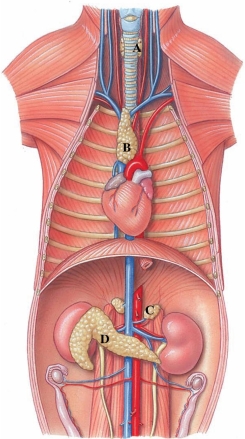
A) A
B) B
C) C
D) D

A) A
B) B
C) C
D) D

Unlock Deck
Unlock for access to all 178 flashcards in this deck.
Unlock Deck
k this deck
66
Which organ, located in the female pelvic cavity, produces estrogen?
A) testis
B) ovary
C) pancreas
D) parathyroid gland
E) thyroid gland
A) testis
B) ovary
C) pancreas
D) parathyroid gland
E) thyroid gland

Unlock Deck
Unlock for access to all 178 flashcards in this deck.
Unlock Deck
k this deck
67
Which artery/arteries supply blood to the brachium?
A) axillary artery
B) esophageal arteries
C) subscapular artery
D) costocervical artery
A) axillary artery
B) esophageal arteries
C) subscapular artery
D) costocervical artery

Unlock Deck
Unlock for access to all 178 flashcards in this deck.
Unlock Deck
k this deck
68
Identify the gland in the figure that produces calcitonin, T3, and T4. 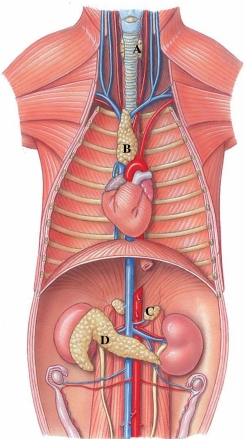
A) A
B) B
C) C
D) D

A) A
B) B
C) C
D) D

Unlock Deck
Unlock for access to all 178 flashcards in this deck.
Unlock Deck
k this deck
69
Which hormone is correctly matched to its function?
A) thymosin; regulates serum glucose levels
B) parathyroid hormone; increases the blood plasma calcium ion concentration
C) T3 and T4; stimulate the bone marrow to produce red blood cells
D) erythropoietin; prepares the uterus for gestation of an embryo
E) mineralcorticoids; stimulate maturation and maintenance of the male sex organs
A) thymosin; regulates serum glucose levels
B) parathyroid hormone; increases the blood plasma calcium ion concentration
C) T3 and T4; stimulate the bone marrow to produce red blood cells
D) erythropoietin; prepares the uterus for gestation of an embryo
E) mineralcorticoids; stimulate maturation and maintenance of the male sex organs

Unlock Deck
Unlock for access to all 178 flashcards in this deck.
Unlock Deck
k this deck
70
The right subclavian artery and the left common carotid artery branch off from which vessel?
A) internal maxillary artery
B) right common carotid artery
C) brachiocephalic artery
D) internal mammary artery
A) internal maxillary artery
B) right common carotid artery
C) brachiocephalic artery
D) internal mammary artery

Unlock Deck
Unlock for access to all 178 flashcards in this deck.
Unlock Deck
k this deck
71
Which blood vessel supplies blood to the deep muscles of the neck and shoulder and to the first two costal interspaces?
A) intercostal artery
B) costocervical artery
C) subscapular artery
D) long thoracic artery
E) ventral thoracic artery
A) intercostal artery
B) costocervical artery
C) subscapular artery
D) long thoracic artery
E) ventral thoracic artery

Unlock Deck
Unlock for access to all 178 flashcards in this deck.
Unlock Deck
k this deck
72
Which type of blood vessels carry blood away from the heart?
A) arteries
B) veins
C) capillaries
A) arteries
B) veins
C) capillaries

Unlock Deck
Unlock for access to all 178 flashcards in this deck.
Unlock Deck
k this deck
73
As the axillary artery enters the forelimb, it becomes the ________.
A) brachial artery
B) costocervical artery
C) femoral artery
D) radial artery
E) ulnar artery
A) brachial artery
B) costocervical artery
C) femoral artery
D) radial artery
E) ulnar artery

Unlock Deck
Unlock for access to all 178 flashcards in this deck.
Unlock Deck
k this deck
74
Which blood vessels supplies blood to the pericardium, mediastinum, and the diaphragm?
A) vertebral artery
B) internal mammary artery
C) ventral thoracic artery
D) internal maxillary artery
A) vertebral artery
B) internal mammary artery
C) ventral thoracic artery
D) internal maxillary artery

Unlock Deck
Unlock for access to all 178 flashcards in this deck.
Unlock Deck
k this deck
75
The celiac trunk divides into three branches. Which one of these vessels is NOT a branch of the celiac trunk?
A) superior mesenteric artery
B) hepatic artery
C) left gastric artery
D) splenic artery
A) superior mesenteric artery
B) hepatic artery
C) left gastric artery
D) splenic artery

Unlock Deck
Unlock for access to all 178 flashcards in this deck.
Unlock Deck
k this deck
76
Identify the pancreas in the following figure. 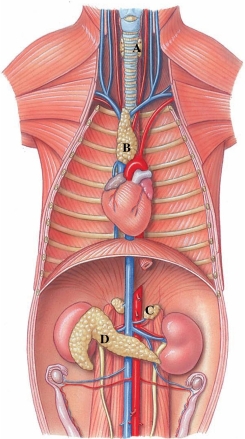
A) A
B) B
C) C
D) D

A) A
B) B
C) C
D) D

Unlock Deck
Unlock for access to all 178 flashcards in this deck.
Unlock Deck
k this deck
77
As the aorta extends posteriorly beyond the diaphragm, it is called the ________.
A) aortic arch
B) thoracic aorta
C) abdominal aorta
A) aortic arch
B) thoracic aorta
C) abdominal aorta

Unlock Deck
Unlock for access to all 178 flashcards in this deck.
Unlock Deck
k this deck
78
Blood leaving the right ventricle enters which blood vessel?
A) pulmonary trunk
B) aorta
C) coronary artery
D) precava
E) pulmonary vein
A) pulmonary trunk
B) aorta
C) coronary artery
D) precava
E) pulmonary vein

Unlock Deck
Unlock for access to all 178 flashcards in this deck.
Unlock Deck
k this deck
79
The celiac trunk branches off the ________.
A) abdominal aorta
B) aortic arch
C) thoracic aorta
D) hepatic artery
E) left gastric artery
A) abdominal aorta
B) aortic arch
C) thoracic aorta
D) hepatic artery
E) left gastric artery

Unlock Deck
Unlock for access to all 178 flashcards in this deck.
Unlock Deck
k this deck
80
Identify the aortic arch in the figure. 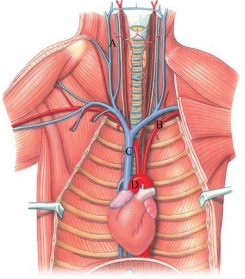
A) A
B) B
C) C
D) D

A) A
B) B
C) C
D) D

Unlock Deck
Unlock for access to all 178 flashcards in this deck.
Unlock Deck
k this deck



